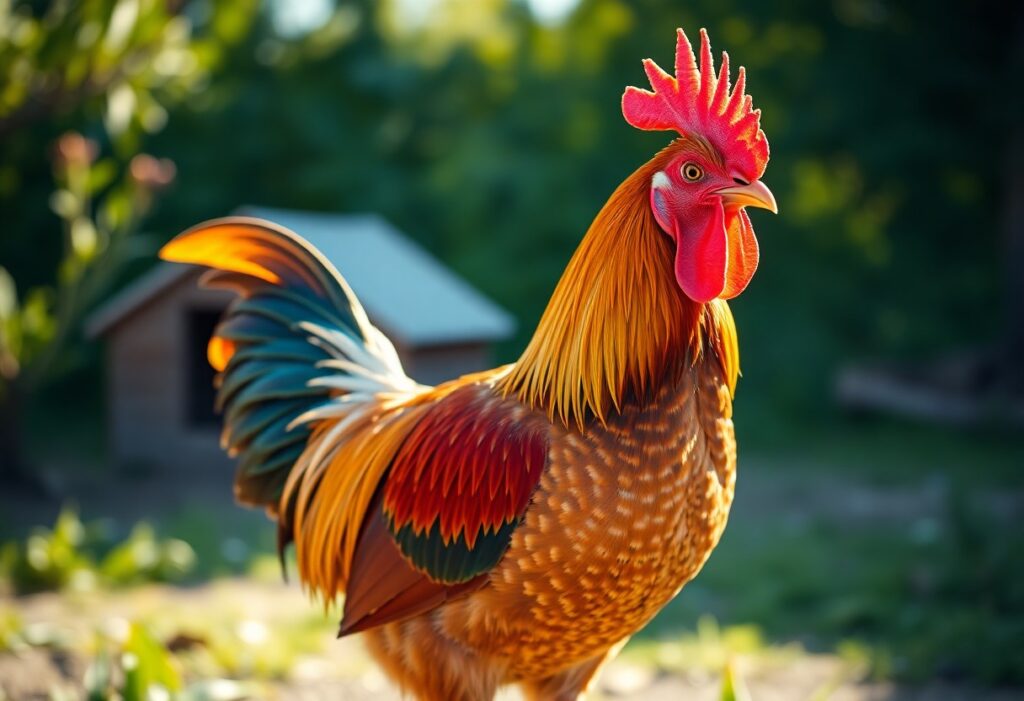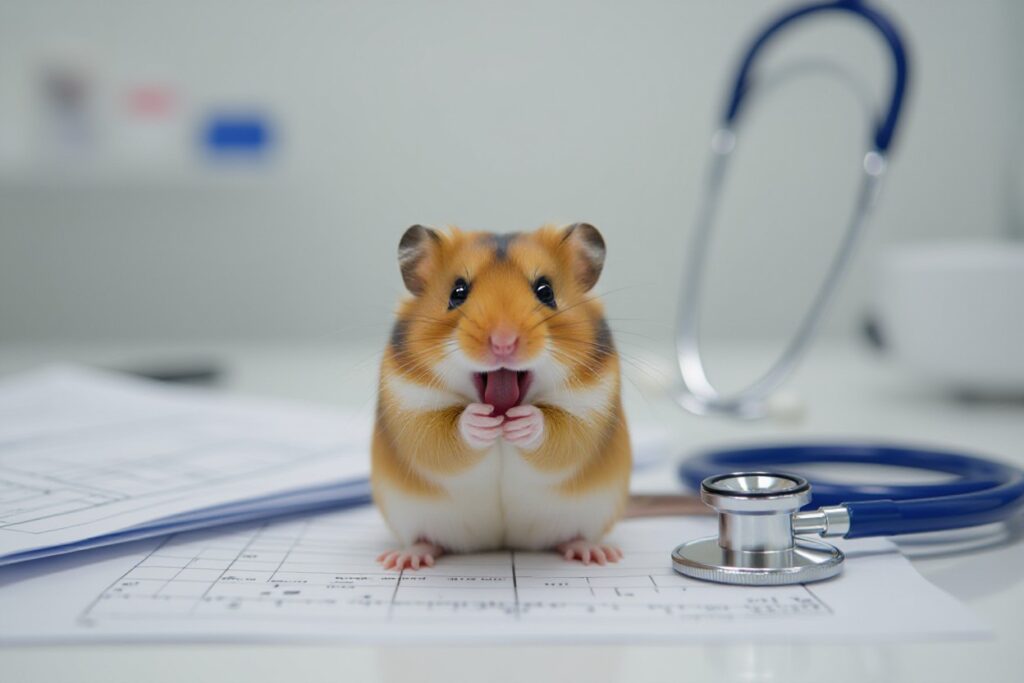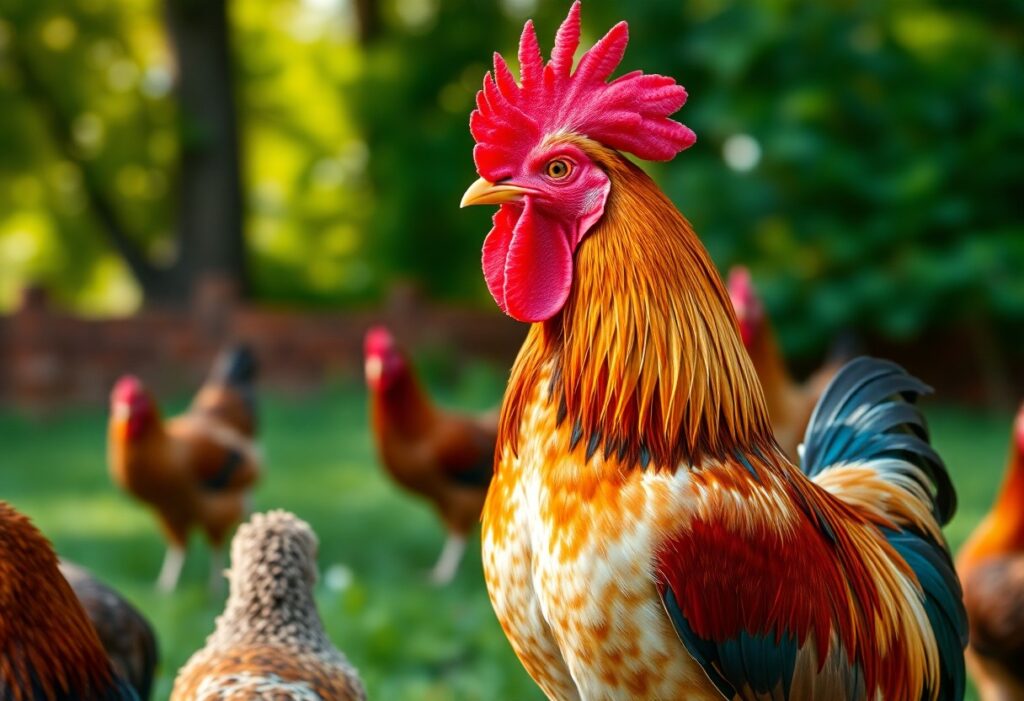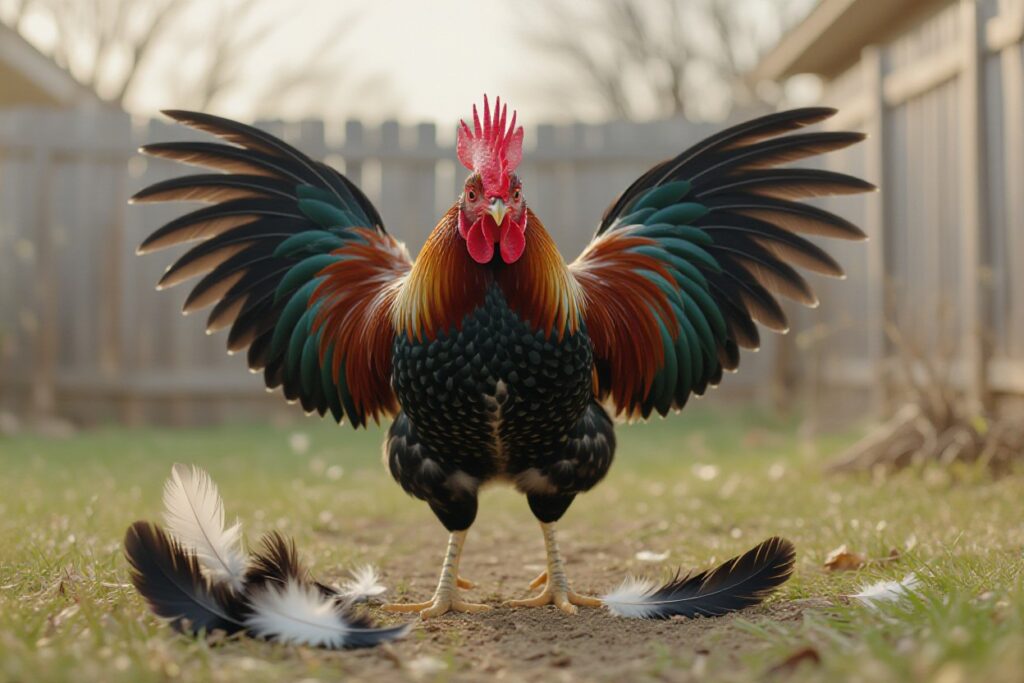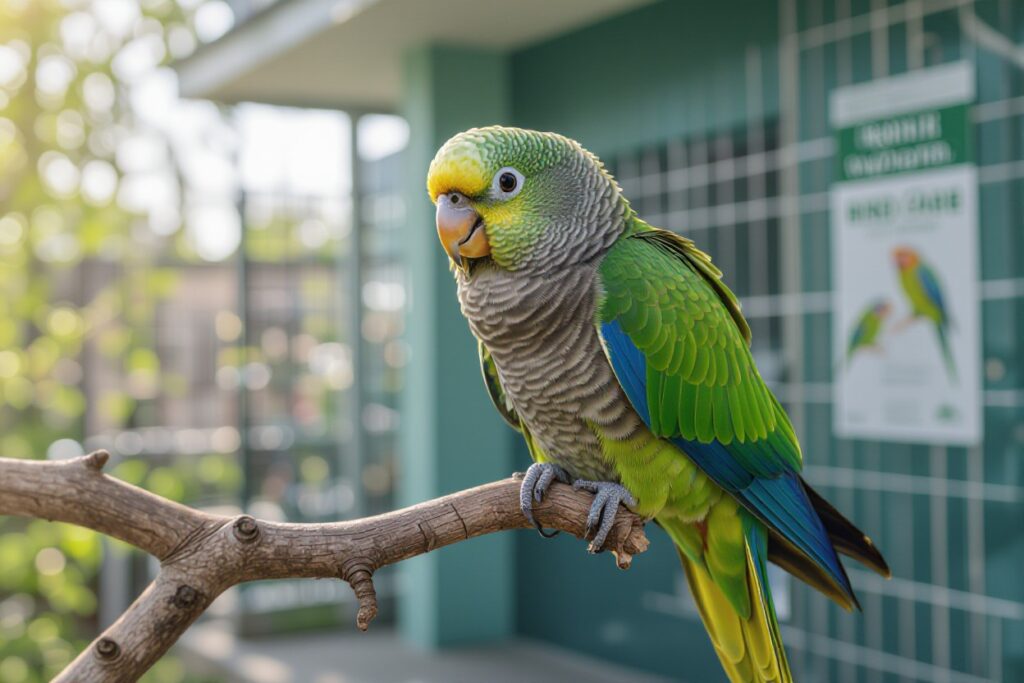Over time, recognizing the key signs of a healthy rooster becomes imperative for any poultry owner. You should be aware of vital indicators such as a bright and alert demeanor, shiny feathers, and a robust appetite, all of which reflect your rooster’s well-being. In contrast, signs like lethargy, weight loss, or unusual vocalizations can signal potential health issues that should not be overlooked. By understanding these indicators, you can ensure your rooster’s vitality and longevity, contributing to a thriving flock.
Key Takeaways:
- A healthy rooster displays vibrant plumage, clear eyes, and an active demeanor, indicating overall well-being.
- Regular behavior such as crowing, foraging, and interacting with the flock is important for a rooster’s mental and physical health.
- Maintaining proper nutrition and access to clean water is key to supporting a rooster’s vitality and reproductive health.
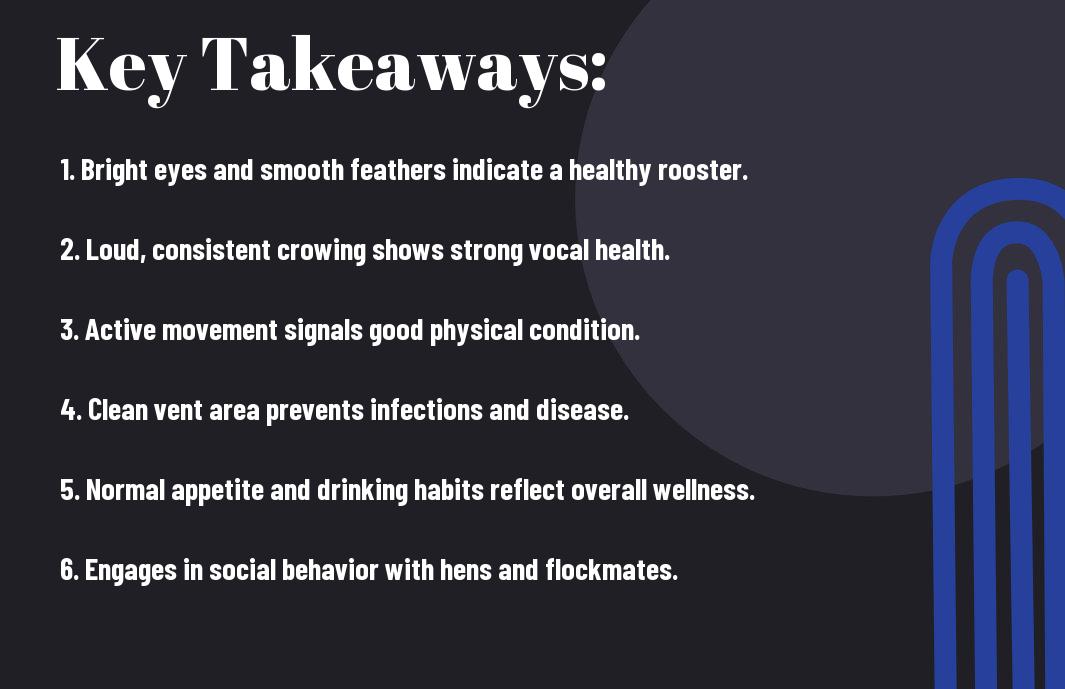
Physical Characteristics of a Healthy Rooster
A healthy rooster presents distinct physical characteristics that indicate his well-being. Look for bright, alert eyes, a vibrant comb, and smooth plumage. His posture should be upright, and he should exhibit energetic behavior. Monitoring these traits will help ensure your rooster is thriving and can fulfill his role in your flock.
Plumage Quality
Any healthy rooster boasts vibrant, shiny feathers that are free of bald patches and damage. Lush plumage not only protects against environmental elements but also signals proper nutrition and grooming practices. Pay attention to the overall feather condition, as it can serve as a reflection of your rooster’s health.
Body Condition
Across all bird species, body condition plays a significant role in assessing health. A well-fed rooster should have a firm body and an adequately filled breast with no visible signs of excessive weight or malnourishment.
For instance, a healthy rooster typically has a fit, muscular build, indicating proper nutrition and exercise. An underweight rooster may have visible bones or a gaunt appearance, which could point to inadequate feeding or health issues. Conversely, an overweight rooster may struggle with mobility and reproductive issues, risking his overall vitality. Monitoring your rooster’s weight and body condition will help you maintain a thriving and productive flock.

Behavioral Indicators
Assuming you are attentive to your rooster’s behavior, you’ll find that it often serves as a clear indicator of his health. Healthy roosters exhibit lively actions and engage actively with their environment, showcasing a range of social and territorial behaviors. Understanding these behavioral signals helps you maintain a thriving flock and take prompt action if you notice any deviations.
Activity Level
Behavioral signs that indicate a healthy rooster include a high activity level, characterized by frequent movement, scratching, and foraging. A rooster that is physically active not only demonstrates good health but also contributes to the well-being of your flock by promoting a dynamic environment.
Social Interactions
Above all, healthy roosters display strong social interactions with both hens and other roosters. They communicate through a range of vocalizations and behaviors, asserting their place in the pecking order while also ensuring the safety and cohesion of the flock.
At the heart of a rooster’s well-being is his need for positive social interactions. When he engages in friendly displays with hens and establishes a respectful hierarchy among other roosters, it indicates a balanced emotional state. However, if you observe signs of aggression or isolation, this may signal underlying issues that require your attention. Social dynamics can greatly affect the flock’s health and happiness, so ensuring your rooster mingles well helps promote a harmonious environment.
Vocalization and Communication
Not all roosters are created equal when it comes to vocalization. A healthy rooster exhibits a variety of sounds that communicate his mood or needs. It’s important for you to pay attention to these vocal patterns, as they can indicate the overall well-being of your bird. Consistent and clear vocalizations are signs of a rooster that is secure in his environment and ready to interact with his flock.
Crowing Patterns
After evaluating a rooster’s health, take special notice of his crowing patterns. A healthy rooster will crow regularly at dawn and throughout the day, signaling his territorial presence. Strong and consistent crows are indicative of good health, while a change in frequency or intensity could suggest stress or illness. Make it a habit to note any deviations, as they can provide insight into your bird’s well-being.
Alarm Calls
Patterns of alarm calls are another important element of a rooster’s communication. Due to their instinctive nature, healthy roosters produce sharp, urgent crows when they sense danger, alerting the flock to potential threats. The absence of these alarm calls can indicate a lack of awareness or, in extreme cases, a sign of illness. As a poultry owner, you should not rely solely on your own instincts; listening for these alarm calls is vital for the safety of your entire flock.
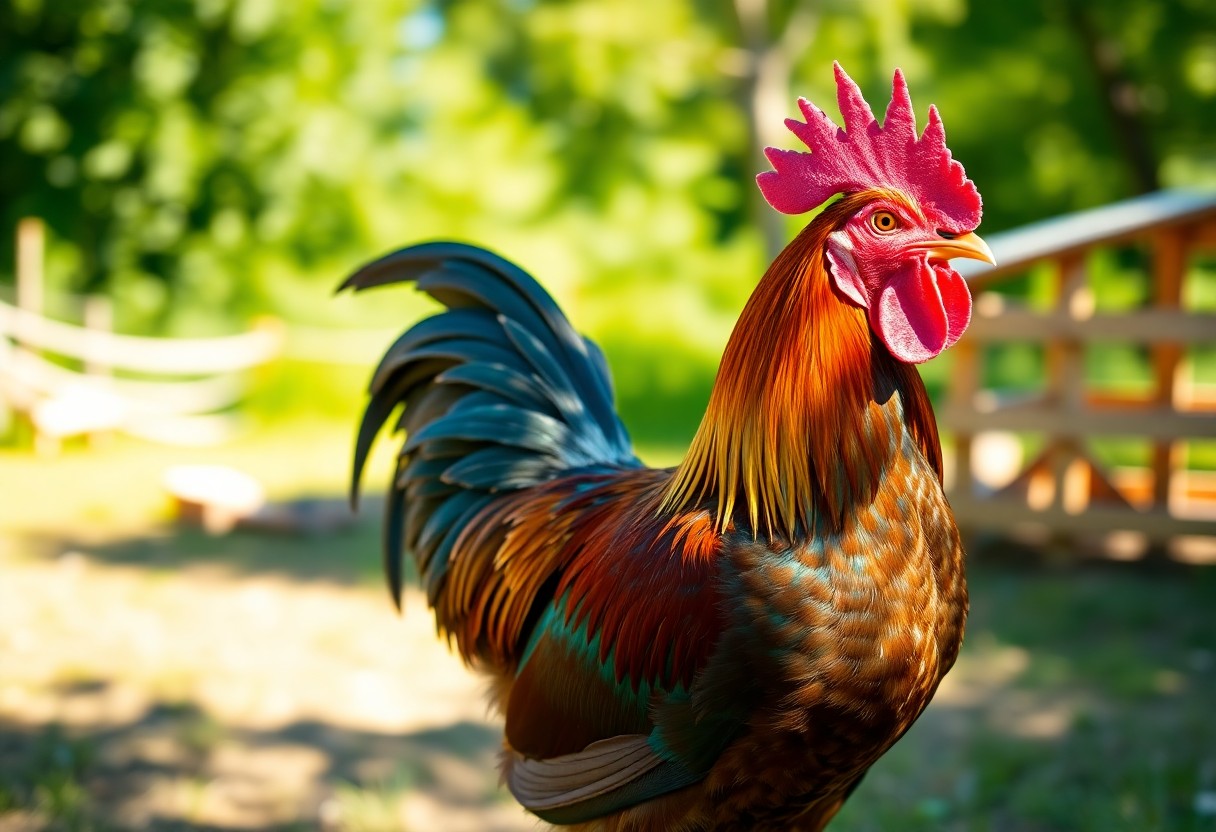
Feeding Habits
For ensuring the well-being of your rooster, it’s important to monitor their feeding habits closely. A healthy rooster should exhibit consistent and robust feeding patterns, which reflect their overall health and nutritional status. Observing what and how much your rooster eats can provide valuable insight into their health and well-being.
Nutritional Needs
Below are some key nutritional components necessary for your rooster’s diet. A balanced diet should include high-quality grains, proteins, vitamins, and minerals. Look for poultry feed specifically formulated for roosters, as it meets their energy and growth requirements.
Eating Behavior
On a typical day, your rooster should show excitement and eagerness during feeding. Healthy roosters often exhibit natural pecking and scratching behaviors that are indicators of good digestive health and contentment.
But if you notice any changes in their eating behavior, such as a lack of interest in food or signs of aggression while feeding, it could signal potential health issues. Ignoring these signs may lead to malnutrition, which can greatly affect their overall vitality and immune function. Ensuring your rooster is fed at regular intervals in a calm and controlled environment reduces stress and promotes a positive eating experience.
Health Assessments
After establishing a solid care routine, it’s vital to conduct regular health assessments of your rooster. Monitor his physical appearance, behavior, and habits closely. Check for any noticeable changes, including how he interacts with the flock, his appetite, and his energy levels. Performing these routine assessments will help you detect potential health issues early, ensuring your rooster remains a vibrant member of your poultry family.
Common Health Issues
About your rooster’s health, be aware of common issues such as respiratory infections, parasites, and nutritional deficiencies. Recognizing the specific signs of these conditions is vital for timely intervention. Regular health assessments will help you identify these problems before they escalate, ensuring long-term well-being for your rooster.
Signs of Illness
Around your flock, observe your rooster for any signs of illness that may indicate that something is amiss. These include lethargy, ruffled feathers, and changes in comb color. Early detection is key; catching these symptoms early can significantly improve recovery chances.
Common signs of illness in your rooster may be subtle but are vital to recognize. Look for prolonged periods of isolation from the flock, poor appetite, or abnormal droppings. If your rooster appears disinterested in his usual activities or shows labored breathing, it is vital to take immediate action. Keeping a close watch for these signs ensures you can respond promptly and provide the necessary care to maintain his health and vitality.
Environmental Factors
Once again, the importance of environmental factors cannot be overstated in determining the health of your rooster. Providing a suitable space is vital for their well-being, which includes:
- Clean living area
- Proper ventilation
- Access to sunlight
- Protection from extreme weather conditions
- Safe and stimulating surroundings
Thou must ensure your chickens thrive in an optimal environment to promote healthy growth and behavior.
Living Conditions
Across the board, the living conditions you provide for your rooster significantly impact its overall health. A well-maintained coop with ample space to move around allows your rooster to express natural behaviors and reduces stress. Make sure there is enough bedding and shelter from the elements, as these are vital for comfort and protection.
Social Dynamics
Above all, the social dynamics within your flock plays a key role in your rooster’s health. A balanced hierarchy and positive interactions can lead to a harmonious environment, while conflicts can result in stress and health issues. Ensure there is enough space for all your birds to establish territories and avoid domination, as overcrowding can lead to aggressive behavior.
Living in a healthy social environment, your rooster must have a strong sense of belonging within the flock. Relationships with hens flow best when pecking order is respected, and over-aggression is minimized. Always observe their interactions; mounting or bullying can lead to severe health risks or even death. Fostering a positive atmosphere helps avoid stressing your rooster, leading to a robust and happy bird.
Conclusion
Taking this into account, understanding the signs of a healthy rooster is necessary for successful poultry management. By observing behaviors such as active foraging, clear vocalizations, and vibrant plumage, you can ensure your rooster contributes positively to your flock. Regularly monitoring your rooster’s health will not only benefit your birds but also enhance your enjoyment as a poultry owner. Prioritizing your rooster’s well-being is key to maintaining a thriving and harmonious environment.
FAQ
Q: What are the signs of a healthy rooster’s plumage?
A: Healthy roosters usually exhibit vibrant and shiny feathers. The plumage should be free from bald patches, lesions, or any signs of parasites. A rooster with an unkempt or dull appearance may be dealing with health issues or nutritional deficiencies. Regular grooming and proper diet contribute significantly to a rooster’s feather quality.
Q: How can I assess a rooster’s behavior to determine its health?
A: A healthy rooster exhibits active and social behavior. It will engage with the flock, crow regularly, and demonstrate normal mating behaviors. Signs of lethargy, isolation, or aggression can indicate potential health problems. Additionally, a passively overly aggressive rooster may be suffering from stress or illness, so observing their behavior in conjunction with other signs is important.
Q: What physical attributes should I look for in a healthy rooster?
A: Key physical attributes of a healthy rooster include bright, alert eyes, a clean and well-formed comb, and strong legs. The comb color should be vibrant and firm, with no signs of wilting or discoloration. A healthy rooster should also maintain a weight that aligns with its breed standard, and its stance should be stable and balanced. Any abnormalities in these attributes may suggest underlying health issues.
